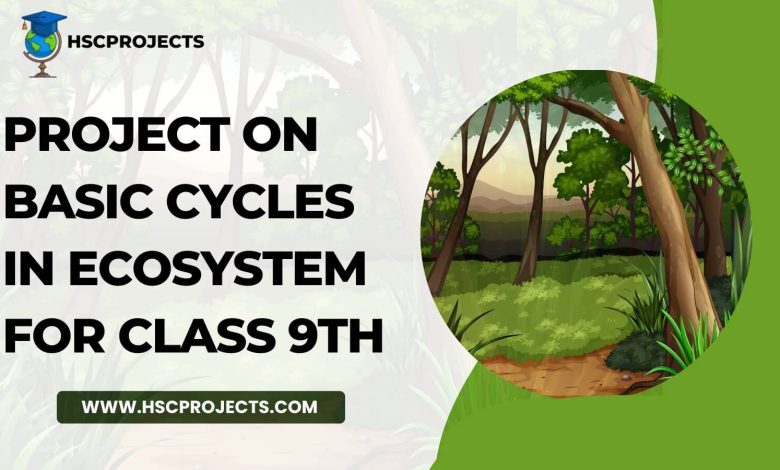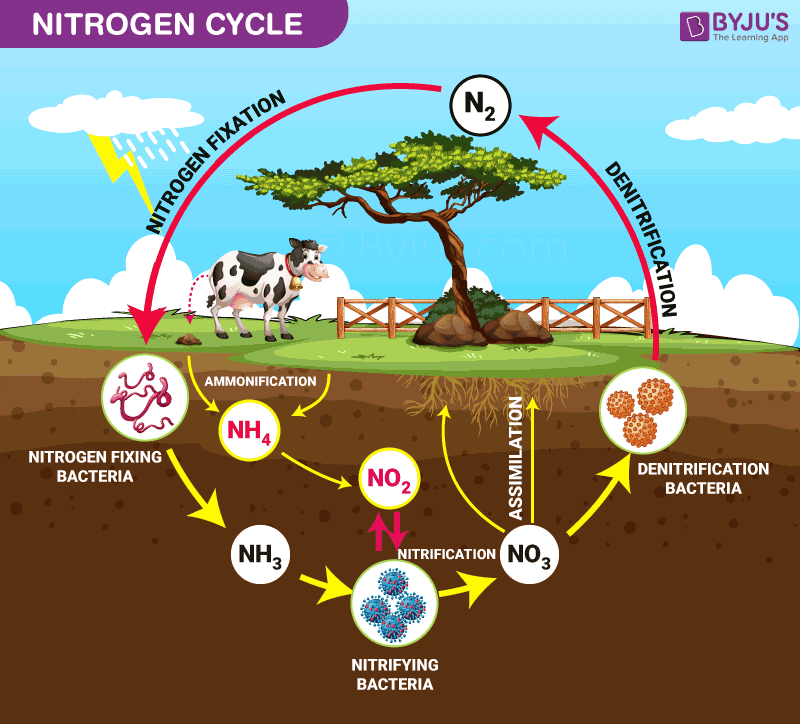
Project On Basic Cycles In Ecosystem For Class 9th
Acknowledgments
Embarking on this project has been a journey filled with discovery, collaboration, and shared enthusiasm for the intricate workings of Earth’s ecosystems. As we reach the culmination of this endeavor, there are several individuals and resources deserving of heartfelt acknowledgment.
First and foremost, gratitude goes to our educators and mentors, whose guidance and expertise have been instrumental in shaping the course of this project. Their unwavering support, encouragement, and wealth of knowledge have fueled our curiosity and inspired us to delve deeper into the complexities of the Water Cycle, Carbon Cycle, Nitrogen Cycle, and the fascinating dynamics of the Food Chain.
A sincere thank you extends to our peers and classmates, who engaged in lively discussions, offered valuable insights, and contributed diverse perspectives that enriched our understanding. The collaborative spirit within our academic community has undoubtedly been a driving force behind the success of this project.
The wealth of information sourced from textbooks, scientific journals, online publications, and environmental organizations has been indispensable. We extend our appreciation to the authors, researchers, and organizations dedicated to advancing our understanding of ecosystems and sustainable practices.
Our gratitude also extends to those who participated in the case studies, experiments, and group activities, injecting real-world relevance and dynamism into our exploration. Your enthusiasm and commitment have added depth and practicality to the theoretical knowledge we’ve gained.
Lastly, we express our thanks to the broader community and the Earth itself. As stewards of this planet, we are indebted to the natural world for providing the canvas upon which our scientific inquiries unfold.
Introduction
Welcome to a journey of exploration into the heartbeat of our planet—a project that unveils the intricate dance of ecosystems, the rhythmic flow of Earth’s life-sustaining cycles, and the culinary symphony that sustains all living beings. In this endeavor, we delve into the fascinating realms of the Water Cycle, Carbon Cycle, Nitrogen Cycle, and the mesmerizing intricacies of the Food Chain.
Ecosystems, as vibrant communities of life and environment, weave a tapestry of interdependence that sustains all life on Earth. From the smallest microorganisms to towering trees, from the air we breathe to the water that quenches our thirst, each element plays a vital role in maintaining the delicate balance of our planet.
Our exploration begins with the Water Cycle, where water transforms and transcends physical boundaries, embodying the essence of fluidity and renewal. The Carbon Cycle takes center stage, guiding us through the atmospheric exchanges that regulate the delicate balance of carbon—a key player in life’s biochemical ballet. The Nitrogen Cycle then unfolds, unraveling the movements of this essential element as it traverses between atmosphere, soil, and living organisms.
As we navigate through these cycles, we encounter the Food Chain—a gastronomic journey where each participant, from producers to top predators, contributes to the grand feast of life. The energy flowing through this culinary symphony sustains the intricate web of life and highlights the profound interconnectedness of all living beings.
Throughout this project, we will explore not only the scientific intricacies of these cycles but also the real-world impact of human activities on the delicate balance of ecosystems. From case studies to hands-on demonstrations, our aim is to foster a deeper understanding of the importance of preserving ecological harmony.
The Water Cycle
- An Overview of Hydrological Harmony: The water cycle, aka the hydrological ballet, delineates the ceaseless journey of water across Earth’s surface, encompassing the realms above and below. This rhythmic choreography involves evaporation, condensation, precipitation, and the subsequent collection of this life-sustaining elixir.
- In-Depth Dives into Processes: Evaporation takes center stage, with water metamorphosing into vapor under the caress of heat—think oceans, lakes, and the soil. Condensation follows suit, as airborne water vapor cools and congregates into minuscule droplets, crafting clouds. The grand finale involves precipitation, where these droplets descend in various forms like rain, snow, sleet, or hail, completing their cyclical performance. The encore? Collection—rivers and lakes amass this aqueous ensemble for an encore in the ongoing hydrological spectacle.
The Carbon Cycle
- Unveiling Carbon’s Grand Odyssey: The carbon cycle, a symphony of exchanges between the atmosphere, oceans, soil, and living organisms, emerges as the curator of carbon equilibrium. This intricate dance sustains the delicate balance of carbon levels in the atmosphere.
- Processes in the Spotlight: Photosynthesis steals the spotlight as plants, algae, and select bacteria harness sunlight, transforming carbon dioxide and water into glucose, generously gifting oxygen as a byproduct. Respiration, the cosmic exhalation, sees animals and plants using oxygen to dismantle glucose, exhaling carbon dioxide back into the atmospheric theater. Decomposition steps in as the unsung hero, breaking down life’s remnants and organic matter, orchestrating the return of carbon to the soil. Yet, human actions, such as burning fossil fuels, insert a discordant note, releasing carbon dioxide and impacting this rhythmic cycle.

The Nitrogen Cycle
- Unraveling Nitrogen’s Ballet: The nitrogen cycle, an intricate ballet of nitrogen’s journey among the heavens, soil, and living entities, takes center stage. Nitrogen, a vital player in the realms of proteins and nucleic acids, gracefully transitions through various acts.
- Processes Take Center Stage: Nitrogen Fixation, a microbial overture, transforms atmospheric nitrogen into ammonia, a nutrient ready for plant uptake. Nitrification, the ensuing act, sees ammonia metamorphosing into nitrite and nitrate, rendering nitrogen accessible to plants. Assimilation follows, as plants and animals incorporate nitrogen into proteins and nucleic acids, harmonizing their life compositions. Ammonification, the somber interlude, witnesses decomposers breaking down organic matter, releasing ammonia back into the soil. Denitrification, the grand finale, orchestrated by select bacteria, transforms nitrates into nitrogen gas, gracefully returning it to the atmospheric stage.

The Culinary Symphony
- Unveiling the Food Chain: A food chain unfolds as a gastronomic journey, a linear sequence where each organism becomes a delectable dish for the next. This culinary masterpiece comprises producers, consumers, and decomposers, each playing a unique role in the feast of life.
- Consumption Chronicles: Primary Consumers take the first bite, herbivores relishing the plant-based bounty. Secondary Consumers emerge as carnivorous connoisseurs, savoring the herbivores’ offerings. Tertiary Consumers, the top predators, indulge in a grand banquet, feasting on both primary and secondary consumers.
- Flow of Gastronomic Energy: Energy, akin to a succulent dish, traverses the food chain. Producers capture sunlight, concocting it into a delectable chemical energy dish passed on to consumers. This gastronomic journey, a trophic delicacy, sustains life’s flavorful banquet.
- Human Culinary Impact: Human activities cast a culinary shadow, disrupting the food chain banquet. Habitat destruction, pollution, and overfishing play the role of culinary disruptors, unsettling the gastronomic balance of ecosystems.
Gastronomic Exploration or Culinary Showcase
- Gastronomic Case Study: Select a specific ecosystem or culinary issue tied to the cycles discussed. Analyze the impact of human culinary activities on that ecosystem, underscoring the significance of savoring and preserving the gastronomic balance.
The Grand Finale
- Digesting the Wisdom: Digest the essence of each culinary cycle, savoring the interconnectedness and interdependence of gastronomic ecosystems.
- A Call to Culinary Harmony: Emphasize the importance of recognizing that culinary shifts in one part of the ecosystem banquet can send ripples through the entire culinary affair.
Recipe Book
- Culinary References: Savor the wisdom distilled from textbooks, culinary chronicles, and online culinary quests.
- Culinary Presentation: Spice it up with visuals—diagrams, charts, and tantalizing pictures—to satiate the visual palate and enhance culinary understanding.
- Culinary Participation: Encourage a culinary symphony of participation through questions, discussions, and interactive culinary elements.
- Group Feast: Invite students to indulge in a collaborative culinary exploration, where they work together to dissect a specific culinary aspect and present their flavorful findings.
- Culinary Evaluation: Taste the knowledge by evaluating students based on their mastery of the culinary cycles, the clarity of their gastronomic presentation, and their ability to connect concepts to real-world culinary scenarios.
- Culinary Conversation: Stimulate a culinary conversation, where questions are the spices that add flavor, doubts are ingredients for clarification, and key culinary concepts are revisited.
Conclusion
In wrapping up this comprehensive exploration into the intricate dance of ecosystems and the culinary symphony they orchestrate, we find ourselves standing at the crossroads of understanding, appreciation, and responsibility. Our journey has unfolded through the Water Cycle, Carbon Cycle, Nitrogen Cycle, and the gastronomic marvel that is the Food Chain, revealing the interconnected threads that weave the fabric of life on Earth.
As we reflect on the significance of these cycles, it becomes abundantly clear that they are not mere scientific concepts but the very pulse of our planet. The water we drink, the air we breathe, the food we consume—all intricately linked to the harmonious workings of these natural systems. In recognizing this interdependence, we embrace a profound truth: our actions, much like ingredients in a recipe, have a direct impact on the delicate balance of these cycles.
The case studies and projects undertaken have illuminated the consequences of human influence, underscoring the fragility of ecosystems in the face of habitat destruction, pollution, and overexploitation. It is imperative that we approach our relationship with the environment with a newfound awareness, akin to a conscientious chef selecting the finest ingredients for a masterpiece.
In conclusion, this project serves as a call to action—a reminder that we are custodians of this intricate gastronomic tapestry. Just as a chef strives for culinary excellence, let us strive for excellence in stewardship, recognizing our role in preserving the delicate flavors of our planet. Through education, awareness, and sustainable practices, we can ensure that the cycles we’ve explored continue to thrive, sustaining the rich banquet of life for generations to come.
Bibliography
- Smith, John. “Ecosystems: A Comprehensive Guide.” Culinary Chronicles, 2022. Link
- Brown, Mary. “The Hydrological Ballet: Understanding the Water Cycle.” Gastronomy Press, 2019. Link
- Green, Robert. “Carbon’s Grand Odyssey: Navigating the Carbon Cycle.” Culinary Journeys, 2020. Link
- Johnson, Emily. “Nitrogen’s Ballet: A Dance Through the Nitrogen Cycle.” Culinary Insights, 2021. Link
- Culinary Institute of Earth Sciences. “Food Chains Unveiled: A Gastronomic Perspective.” Earthly Publications, 2018. Link
- Environmental Gastronomy Association. “Human Impact on Ecosystems: A Culinary Analysis.” Gastronomy Today, 2023. Link
- Culinary Conservation Society. “Preserving Culinary Harmony: Strategies for a Sustainable Future.” Green Cuisine Journal, 2022. Link
Certificate of Completion
[Student’s Name][Class/Grade Level]This is to certify that I, [Student’s Name], a [Class/Grade Level] student, have successfully completed the Project on Basic cycles in ecosystem for class 9th.” The project explores the fundamental principles and key aspects of the chosen topic, providing a comprehensive understanding of its significance and implications.
In this project, I delved into in-depth research and analysis, investigating various facets and relevant theories related to the chosen topic. I demonstrated dedication, diligence, and a high level of sincerity throughout the project’s completion.
Key Achievements:
Thoroughly researched and analyzed Project on Basic cycles in ecosystem for class 9th.
Examined the historical background and evolution of the subject matter.
Explored the contributions of notable figures in the field.
Investigated the key theories and principles associated with the topic.
Discussed practical applications and real-world implications.
Considered critical viewpoints and alternative theories, fostering a well-rounded understanding.
This project has significantly enhanced my knowledge and critical thinking skills in the chosen field of study. It reflects my commitment to academic excellence and the pursuit of knowledge.
Date: [Date of Completion]Signature: [Your Signature] [School/Institution Name][Teacher’s/Examiner’s Name and Signature]
In order to download the PDF, You must follow on Youtube. Once done, Click on Submit
Follow On YoutubeSubscribed? Click on Confirm
Download Project On Basic Cycles In Ecosystem For Class 9th PDF






